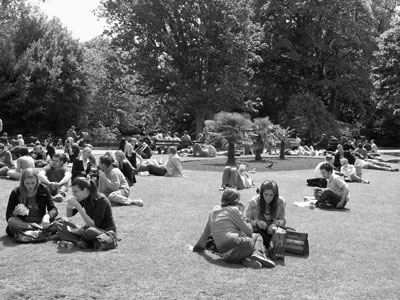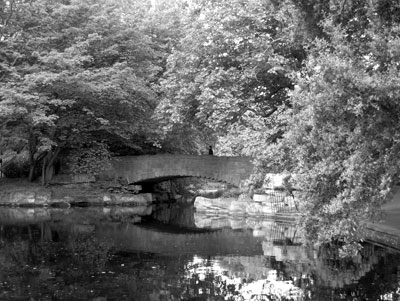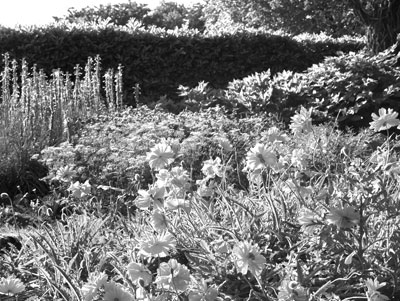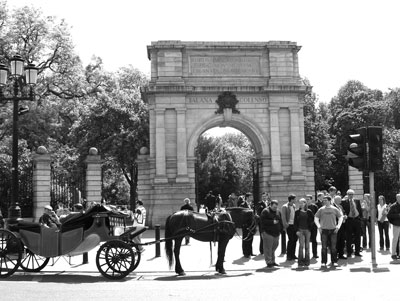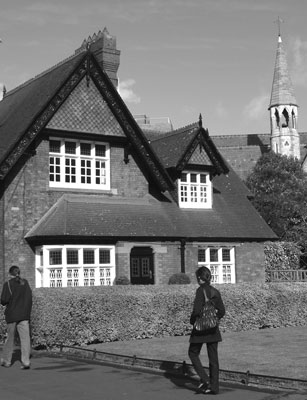In Dublin’s fair city: St. Stephen’s Green
This item appears on page 82 of the October 2008 issue.
by Yvonne Horn
As autumn rustled the last of the leaves from St. Stephen’s Green’s trees, Margaret Gormley, Park Superintendent for Ireland’s oldest public park, already had Ireland’s most famous park’s spring color palate in mind.
In the park’s enormous glass house, long tables of rose, yellow, white and red polyanthus seedlings would share space with flats of wallflower in shades of scarlet and gold. Pansy starts would be well represented — white, yellow and blue. Hyacinth bulbs were at the ready, destined to poke forth in the spring to add jewel tones and fragrance to the garden’s borders.
All were synchronized to be in the ground and come into bloom precisely when beds containing hundreds of tulips came into full flower.
“Ah, the Green is well known for its tulips,” Gormley said. “All of Dublin turns out when the tulips are in bloom.”
Medieval legacy
Dublin’s love affair with St. Stephen’s Green dates back to medieval times when it was a marshy commons on the edge of the city. In 1664, as a means of raising revenue, the center of the Green was walled, and building lots were sold around its edges.
Clearly stated was that the center would remain “wholie kepte for the use of citizens and others, to walke and take the open aire, by reason this cittie is at present groweing very populous.”
Through the centuries, “citizens and others” have freely used its 22 acres, save for a period beginning in 1814 when the city, again lacking funds, locked it up. Keys were sold to the residents of the fine Georgian houses that graced its perimeter. So it remained for over 60 years.
Lord Ardilaun, chairman of the Guinness brewery, grew up in one of those fine, key-holder houses and retained fond memories of visiting the Green with his nanny. Believing it not right that but a few could enter, he bought out all the keys and embarked on three years of extensive landscaping.
In 1880, with the Green emerged as a Victorian Park, he presented it to the city. St. Stephen’s Green, once again, was open to all.
Victorian showcase
“The garden’s philosophy is to remain faithful to the Victorian period,” Gormley said, adding that in the 1960s and ’70s the Green began to lose its way, most notably with the introduction of massive contemporary sculpture.
One such sculpture is of Wolfe Tone, a leading light in the United Irishmen movement, whose stark representation is backed with slabs of granite. “Tonehenge,” fast-witted Dubliners quickly dubbed it.
Gormley’s planting scheme reflects that era. In summer, the Green’s formal, circular center turns into a typical Victorian, exotic, tropical-foliage showcase tumbling with banana, bird-of-paradise, rubber and cast-iron plants and brilliantly hued cannas. Beds surrounding the center turn become an eye-popping display of red and pink geranium edged in sage, interspersed with plantings of cineraria, fuchsia and heliotrope.
By contrast, the remainder of the Green’s acreage is largely a subdued collection of noble trees and mature shrubs tied together by meandering paths and herbaceous borders. There are great expanses of lawns, tucked away small ones, a large lake fed by a waterfall and crossed by an arched bridge, and a bandstand where live music attracts throngs for summer concerts.
It also claims a house, a Queen Anne that looks all the world like a storybook escapee. By an 1880 act of Parliament, it is here that park superintendents are required to live.
In 1993, Gormley moved into the house as a single person; it now is home to a family of four. Besides their living in what amounts to a fishbowl, an architectural oddity of the house, which was designed as an aesthetic feature of the park with lesser thought to livability, is that its rooms don’t line up with the windows.
Dublin’s living room
A day at St. Stephen’s Green begins at morning light, when gates open, with joggers and speed-walkers waiting to enter what Dubliners call “the lungs of the city.” Soon the Green bustles with briefcase-carrying office workers taking shortcuts to their places of business via corner-to-corner footpaths.
By 9 o’clock elderly citizens are claiming bench space, with some, according to Gormley, settling in to spend the day observing the ever-passing parade.
Mid-morning introduces perambulators, youngsters chasing ducks around the lake and the first of hundreds of tourists wandering through.
At the entrance arch facing Grafton Street, a busy pedestrianized way, horse-drawn carriages wait to take sightseers on a clip-clop tour around the square. A street performer takes advantage of noontime traffic into the park to reenact the character Dubliners refer to as “the Tart with the Cart,” known to the rest of the world as sweet Molly Malone, “selling cockles and mussels, alive, alive-o.”
Lunchtime, on sunny days, ensures that every square foot of lawn is occupied by brown baggers.
“All of the Green’s lawns are open for day-long lounging, except for that in the central area,” Gormley said, adding that the sit-anywhere-you-like policy creates a bit of a problem when it comes to finding lawns uncluttered with people so that grass can be mowed.
“The park is maintained to high standards,” she added. “Lots of money is invested into keeping it well tended 365 days a year. And in making certain that it’s a safe and comfortable place to be. St. Stephen’s Green is a place of pride for not only Dublin but the entirety of Ireland.”
A popular song goes, “Dublin can be heaven, with coffee at eleven and a stroll around St. Stephen’s Green.”
Strolling ends at 20 minutes before sunset when a clanging hand bell is carried through the park announcing that the gates are about to be locked for the night. Thus ends another day in the life of Dublin’s beloved St. Stephen’s Green.
The Green is a lung for the city,
The Green is a place to walk and think,
And sit and listen to the poets being witty,
Because poetry in Dublin flows like drink.
— Ian McMilton,
Poet in Residence
Yvonne Horn can be reached at www.travelwiththegardener.com.

